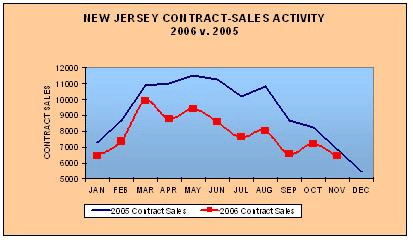From NJBIZ:
Home Mortgage Foreclosures Soar
Rising foreclosure rates in New Jersey are likely to remain on the upswing in 2007, but experts say the odds are slim that the increases will signal a crisis for the state’s housing market or its economy.
For the first 11 months of 2006, home mortgage foreclosures in the state were 25,472, up 78 percent from 14,311 for all of 2005, according to Foreclosures.com, a real estate advisory firm in Sacramento, Calif.
Big increases occurred throughout the state. In affluent Bergen County, foreclosures jumped more than tenfold, from 104 in 2005 to 1,367 last year. In Monmouth County, home to many shore communities, foreclosures rose from 883 in 2005 to 1,533 last year.
An increase in foreclosure rates tends to be symptomatic of an economic downturn, when homeowners lose jobs and therefore lack the income to pay their mortgages, says Jeffrey Otteau, president of Otteau Valuation Group, a real estate appraisal firm in East Brunswick.
But this doesn’t apply to current circumstances, says Joel Naroff, chief economist at Cherry Hill-based Commerce Bank. “It’s not as if the New Jersey economy is falling apart, and unemployment rates are rising, and people are losing their jobs,” says Naroff. “That’s just not happening.”
Instead, rising interest rates that have increased housing payments for adjustable-rate mortgage (ARM) holders, together with a weak housing market, have driven up foreclosure activity, Otteau says. Foreclosures are less common in healthy market conditions, he says, because homeowners are able to sell their homes quickly if they fall behind in their mortgage payments.
“But when you have people with an affordability issue on top of the fact that houses are taking a very long time to sell, that’s when the foreclosure market spikes,” he says.
…
With the housing slowdown, subprime borrowers increasingly feel the pinch. “Because of the imaginative mortgages kicking in, we’re now seeing foreclosures where we hadn’t ever seen them before,” says Naroff. “A lot of these mortgages are resetting, and as they reset, people are finding it difficult to either pay the higher reset levels or remortgage, especially in light of a housing market that’s softening.”According to MBA’s National Delinquency Survey for the third quarter of 2006, 4.68 percent of subprime ARMs in New Jersey were in foreclosure, compared with 0.75 percent for prime ARMs.
Subprime foreclosures are clearly on the increase, according to the Center for Responsible Lending in Durham, N.C. It reported last month that subprime loans that originated last year in New Jersey have a projected lifetime foreclosure rate of 19.6 percent, compared with a projected 7.6 percent rate for such loans made between 1998 and 2001.
Mortgage lenders helped to proliferate the use of creative mortgages by relaxing their loan approval standards during the housing boom, Otteau says. Many lenders assumed that housing appreciation would continue, so they could recover the money that was borrowed if a loan went into default. “Mortgage lenders became very aggressive in trying to get their share of the market or increase their share of the market,” he says.
…
Most experts do not currently see the rise in delinquencies and foreclosures as cause for alarm. “The foreclosure inventory rate has increased somewhat from the very lowest point, but relative to where we’ve been in recent history, it’s still quite low,” says Mike Fratantoni, senior economist at the MBA in Washington, D.C. For the third quarter of 2006, less than 1 percent of the 1.2 million loans the organization tracks in New Jersey were in the foreclosure process, compared with 1.86 percent of loans during the recession in 2001.“That the number of foreclosures is increasing was to be expected, because we were at an incredible low point here in terms of the amount of foreclosure activity in the market, so it could only go up,” says Otteau. The current numbers, he adds, are less than those in previous periods of high foreclosure rates, including the late 1980s and early 1990s, and the late 1970s and early 1980s.
While New Jersey may have more foreclosures and a faster rate of increase than other states, “that comes as no surprise,” says Otteau. “We have more households, we have a more active housing market, and we have a more expensive housing market than other states.”
…
However, says Otteau, “If we do get a recession in ’07, which is not likely but possible, that would be the perfect storm that would cause the foreclosure rate to increase more rapidly, and at that point it could become a serious factor for the housing market.”

